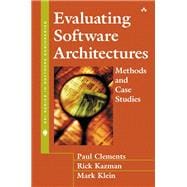The foundation of any software system is its architecture. Using this book, you can evaluate every aspect of architecture in advance, at remarkably low cost -- identifying improvements that can dramatically improve any system's performance, security, reliability, and maintainability. As the practice of software architecture has matured, it has become possible to identify causal connections between architectural design decisions and the qualities and properties that result downstream in the systems that follow from them. This book shows how, offering step-by-step guidance, as well as detailed practical examples -- complete with sample artifacts reflective of those that evaluators will encounter. The techniques presented here are applicable not only to software architectures, but also to system architectures encompassing computing hardware, networking equipment, and other elements. For all software architects, software engineers, developers, IT managers, and others responsible for creating, evaluating, or implementing software architectures.









